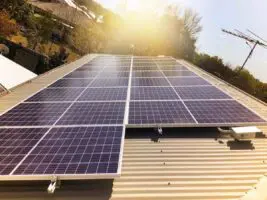Australia’s solar industry remains confident that the amount of solar installed in the country could triple by the end of the decade, buts its ambitions appear to pale in comparison with those of the conservative government in the UK.
The Australian Photovoltaic Institute last week said that forecasts for uptake in the next few years suggest that a level of 8-9GW (the current level is just over 3.1GW) is “very easy to project.”
APVI chairperson Muriel Watt told a conference last week that the incumbent fossil fuel industry might “wish them (the solar industry) away, but it was not going to happen, with retail parity in the current reached in 2011/12, well ahead of expectations. Installations could well double again by 2030. Or it could quadruple in that decade with growth of around 15 per cent.
The 2020 forecast was echoed in a discussion paper issued by the government’s RET Review panel, which suggested that 11,000GWh of electricity could be produced by small scale generation in Australia by 2020.
Australia’s currently has an overall renewable energy target, but this is under review, and so is the level of any government incentive or support. The Abbott government has a “million solar roofs program” – which might be worth 3GW of solar in itself given the average size of rooftop installations – but has given no indication of how this might be implemented.
But while sun-rich Australia seemingly meanders its way to 9GW with no official government targets and only the support of households as the main driver, the sun-challenged UK is aiming for at least 20GW of solar by 2020 – or at least that is the target of its energy minister.
The UK last week became the first European government to publish a dedicated solar PV strategy, and in 2014 it is set to overtake Germany as the largest market for solar PV in Europe. It has total capacity of 4GW.
“We have managed to put ourselves among the world leaders on solar and this strategy will help us stay there,” energy minister Greg Barker told reporters last week.
“There is massive potential to turn our large buildings into power stations and we must seize the opportunity this offers to boost our economy.”
The Guardian reports that the UK strategy places particular emphasis on encouraging the deployment of rooftop solar, especially the underperforming commercial-scale sector. In addition, the strategy confirms that the government is targeting one million solar homes by 2015 (and not indefinitely as in Australia).
“Solar not only benefits the environment, it has the potential to create thousands of jobs across the region and deliver the clean and reliable energy supplies that the country needs at the lowest possible cost to consumers,” the report finds.
The UK strategy is very much focused on rooftop solar, and expresses caution about the proliferation of large ground-mount solar farms, warning it could face the same rebound from residents as large wind farms.
“I do not want solar farms to become the new onshore wind,” Barker said. “Solar power enjoys huge popularity, so we have to be careful. I do not want to see unrestricted growth of solar farms in the British countryside.”
The Guardian said that Barker has previously called large farms “monsters” and, due the subsidies they receive, “gold-diggers”.
However, he announced a program to put 1GW of solar panels on government owned buildings by 2020, and on the roofs of all 22,000 schools.
Last week, car maker Jaguar announced the completion of the UK’s largest rooftop solar array, with 21,000 panels on the roof of their engine factory in Staffordshire providing a capacity of 5.8MW.
The largest rooftop solar array in Australia is just 1.2MW. Australia must have smaller rooftops.











